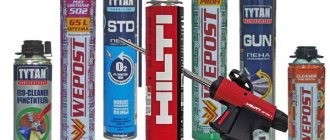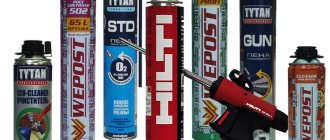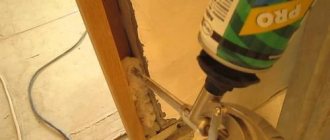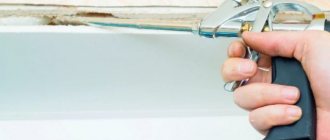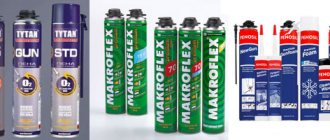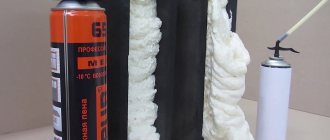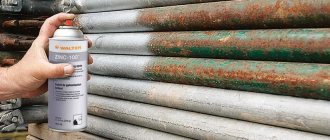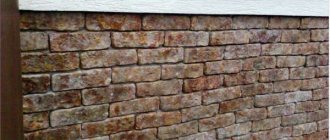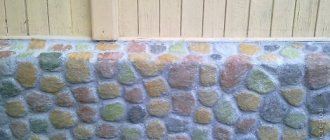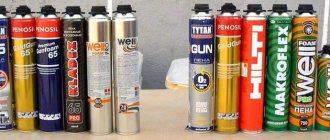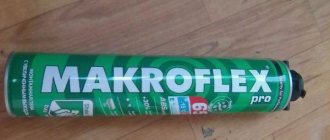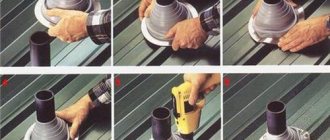Polyurethane foam TYTAN LEXY 20 300 ml. Photo by Maxidom
Polyurethane foam is used to solve a wide range of problems: for sealing cracks and gaps, filling joints when installing windows, doors and other structures, it is possible to use a waterproofing composition. The demand for foam creates many questions among potential and existing performers; answers to some are presented below.
Characteristics
Adhesive foam for polystyrene foam is a polyurethane-based composition, ideal for attaching slabs for exterior and interior decoration of a house. This adhesive material is characterized by an increased degree of adhesion, water resistance and excellent thermal insulation properties.
In addition, the adhesive foam for polystyrene foam (expanded polystyrene) does not contain freons, which ensures its environmental friendliness and harmlessness to humans.
Advantages:
- one cylinder is enough for 10-12 square meters of area;
- there is no need to stir or dilute the composition with water, it is already ready for use;
- the foam is easy to apply, and excess is removed extremely simply;
- the glue hardly expands;
- the composition hardens in a few hours;
- Provides high-quality, reliable and durable fastening.
A conventional cementitious mixture requires effort when installing polystyrene foam boards and it hardens for at least 24 hours, which significantly slows down the finishing work.
Disadvantages of foam adhesive:
- high price;
- Application must be done using a special gun or tools.
Not all manufacturers make high-quality products, so you should choose adhesive foam from well-known brands with a good reputation.
Rules for installation work
Foam adhesive for polystyrene foam is used at positive temperatures with a limit of +35 degrees Celsius. The actual range should be checked in advance on the packaging of a specific sample. Before use, the container must be kept at room temperature for several hours. A gun or the supplied device with a tube is installed in place of the valve. Next, you need to shake the mass. The manufacturer indicates on the packaging the number of shakes or time period. After this, the material is ready to be applied to the working base.
Let's consider further actions with foam in relation to polystyrene foam. A thin strip no more than 30 mm thick should be formed around the perimeter with a distance of approximately 20 mm from the edges. On the main part you can draw diagonal lines or 2-3 parallel to the long edge of the strip.
Source infradom.ru
The next step is gluing the workpiece onto a flat surface. Adjustments and pressing of the plate must be carried out immediately. Pressing should be done without force. The polymerization process occurs in approximately 5 minutes. If you need to move the workpiece away from the wall, then just pierce it in the right place and run a small amount of adhesive inside. Excess can be cut off after 20-30 minutes. Then the voids in the seams are filled.
In this video, the master demonstrates testing three samples of adhesive foam for peel strength after 24 hours:
Manufacturers of adhesive foam
The best adhesive compositions with exceptional characteristics are produced by manufacturers in France and Germany. In second place in terms of quality are products of Polish, Turkish and Estonian brands.
Domestic glue can be quite good, but sometimes there are downright low-quality products.
Advice! You should not purchase glue made in China, since such compounds are not durable and are often toxic.
The best foam adhesive for attaching polystyrene foam boards:
- TechnoNIKOL;
- Macroflex 65;
- Tytan Styro 753.
TechnoNIKOL
At the moment, two types of adhesive foam are produced under the Technonikol brand:
- 500 PROFESSIONAL universal,
- polyurethane for expanded polystyrene.
500 PROFESSIONAL is universally waterproof and mold resistant. It has excellent adhesion properties to silicates, brick, concrete, all types of plasters, wooden surfaces, ceramic tiles and chipboards.
The adhesive is used for fastening slabs of various insulation materials (mineral wool, polystyrene foam, expanded polystyrene), filling voids and cavities, sealing, gluing false stucco, baseboards and other elements.
The setting time of the composition is 10 minutes, final hardening occurs within 24 hours, the density of the glue after hardening is 25 g per cubic centimeter (the structure does not become heavier), thermal conductivity is 0.035 W/mK.
After interaction with atmospheric oxygen, the composition acquires a soft blue color. It is allowed to work with glue at ambient temperatures from 0 to +35° C.
Polyurethane for expanded polystyrene contains polyurethane, which, after interacting with atmospheric oxygen, increases in volume by a maximum of 10% with the release of isobutane gas.
The adhesive is designed specifically for fastening polystyrene foam boards, but is also suitable for other thermal insulators of synthetic origin, for example, polystyrene foam or extruded polystyrene foam.
The composition is used for fixing finishing elements inside and outside buildings, insulating joints, foundations, basements, floors and walls, gluing polystyrene foam boards, sealing joints and seams.
After setting, the adhesive foam almost does not expand, is resistant to moisture and the appearance of mold, perfectly fills gaps and joints, and has increased adhesion to concrete and other surfaces. Setting time is 10-15 minutes. Cannot be used at temperatures below 0°C.
Both types contain isocyanate oligomers, which release isobutane and propane under the influence of atmospheric oxygen. Available in cylinders of 400, 750, 1000 ml. They are characterized by moisture resistance, good adhesive properties, and are used for exterior and interior decoration.
Is it possible to glue...
Such questions arise for the reason that polyurethane foam is sold at a more affordable cost . It is possible to glue insulation boards with polyurethane foam, but the material fixed in this way will not be able to withstand significant loads on the openings . to use mounting compounds as an alternative to glue for the following reasons:
- the adhesive foam contains special additives that improve adhesion, so the materials are fixed much more efficiently and with better quality;
- polyurethane foam has a high expansion rate , which is a negative characteristic for an adhesive material.
Axton professional mounting foam, 750 ml. Photo by Leroy Merlin
Thus, it is not recommended to save on building materials by replacing glue with foam. Since this may have negative consequences that will arise after some time. Peeling of the thermal insulation layer or other problems may occur As a result, each product must be used strictly for its intended purpose. However, there are situations when installation on foam is possible. In addition, there is interest in work of this type. Therefore, it is necessary to consider the sequence of work.
... plasterboard, how to glue it to the wall
The classic way to attach plasterboard sheets is to attach them to an assembled frame of profiles and guides. Fixation is carried out using ordinary self-tapping screws, the tool used is a drill. It is advisable to use polyurethane foam to fix gypsum board sheets in several situations:
Professional mounting foam MAKROFLEX 750 ml. Stroylandia Photos
Prompt installation required. Final setting occurs within several hours, which is significantly less than that of putty mixtures.
Small work area. Laying drywall on foam is not recommended if the number of gypsum board sheets placed on one surface exceeds eight pieces. Since fitting the elements is the most difficult part of the work.
A small number of small-sized plots. Blank walls are recommended as a base for fixing drywall to mounting foam. The presence of window and door openings complicates the work process. Small-sized elements are difficult to position in a single plane, which leads to the need to form an additional plaster layer.
Minor unevenness of the base. Installation can be carried out with surface defects with differences of no more than 30-50 mm.
Saving room space. Foam fixation minimizes space loss, which is especially important in small apartments and rooms.
Cheap work. The cost of installation with profiles and guides is significantly higher than the cost of performing work with foam.
When choosing polyurethane foam, it is recommended to pay special attention to products in the middle price segment. It is better to choose a composition from a well-known brand/manufacturer, which eliminates the purchase of low-quality products. The optimal solution is a composition with a low expansion coefficient.
Polyurethane foam TYTAN Professional Lexy 60 all-season 750 ml. Photo Petrovich
The installation process is not particularly difficult. Regardless of the installation technology, work begins with preparing the base . The surface is cleaned of old coating , dust and dirt. It is recommended to remove the plaster layer, if any, to eliminate the possibility of collapse. Gaps and cracks need to be covered . To level a through defect, it is necessary to make every effort to prevent the appearance of cold bridges. Areas damaged by fungus and mold are cleaned and treated with special products. Applying a primer improves adhesion, which is especially important for concrete bases. After the preparatory work has been completed, you can begin the main process. There are two technologies:
1) Applying foam to the sheet and then attaching it to the base . This technology is suitable for working with flat surfaces. The step-by-step instructions are as follows:
- the foam is applied evenly along the perimeter of the sheet with a distance of 20-30 mm from the edge, and then with zigzag movements on the remaining surface of the drywall, left for 10-15 minutes; for working with various materials there is a general technology for applying the composition; standard recommendations will allow you to obtain a high-quality result;
- The gypsum board is carefully lifted, placed on the base and fixed;
- using a level, leveling is carried out;
- before fixing the drywall, supports are installed;
- the rest of the surface is processed in the same way.
Mounting foam MACROFLEX WhiteTeq professional 750 ml. Photo by Maxidom
To attach drywall to a base with defects, it is necessary to use a second technology, the implementation of which takes more time. To implement it you need:
- holes are drilled in the sheets (9-12 pieces at an equal distance from each other) for self-tapping screws;
- the location points of the holes are transferred to the base, in which recesses for plastic plugs are also drilled, self-tapping screws will be screwed into them;
- the drywall is placed in place and secured with self-tapping screws;
- adjusting the depth of the screws allows you to achieve the required position of the sheet;
- next to the existing holes, others are formed, at a distance of 50-80 mm, through which the mounting foam is CAREFULLY introduced into the space between the base and the gypsum board.
…wallpaper
Wallpaper can be glued to polyurethane foam, but to do this it is necessary to trim the hardened polyurethane composition well to obtain a smooth surface . Or it is possible to repair surface defects with plaster. Then it is recommended to putty the surface, sand it and wallpaper it. The use of polyurethane foam does not make the work easier and does not provide any financial benefits, so it is recommended to adhere to traditional technology for working with wallpaper.
Professional mounting foam TECHNONICOL 65 MAXIMUM all-season 1000 ml. Photo Petrovich
...tiles
Ceramic tiles and tiles can be fixed using polyurethane foam. Even polyurethane foam with a low expansion coefficient increases in volume, albeit slightly, as a result the quality of the cladding will be poor. In addition, finishing materials have quite a significant weight (especially in comparison with plasterboard), so there is a high probability of collapse.
...other materials
1) Plastic panels/PVC panels. The finishing material can be securely fixed to the mounting foam. But this method of fastening has a significant disadvantage. As the foam dries and hardens, it expands in volume. As a result, the panels fixed in the required way will “lead” after some time (8-12 hours). The treated surface will acquire a wavy relief. Thus, it is recommended to use special glue or liquid nails to obtain a quality result.
2) MDF panels. Fixing MDF panels with mounting foam will lead to a similar result. It is almost impossible to achieve an even coating. Therefore, for an even base, it is recommended to use liquid nails and foam adhesive. For surfaces with defects, the technology of lathing formation is suitable.
3) Penoplex. To fix penoplex to the wall, it is recommended to use foam adhesive. But the option with polyurethane foam also has a right to exist. It is only necessary to duplicate the fastening to the base, for example, foam and mushroom dowels.
4) Foam plastic. In this case, in addition to the standard problem with increasing the composition in volume, another one arises - the foam melts the foam, which guarantees the reliability of the fixation.
Thus, high adhesion to many building materials allows the use of polyurethane foam as an adhesive . But there are many nuances and there is a high probability of problems arising . The main difficulty is obtaining an uneven coating. It can be solved by applying foam of the same volume to all elements of finishing materials, but this is problematic. Therefore, it is recommended to use special means for fixing different types of facing materials. Purchasing polyurethane foam will allow you to save only at the initial stage. Then the work will need to be redone.
Macroflex
Makroflex MF 901 adhesive foam is a universal one-component high-quality composition used for quick connection of structures and different materials. Used for external and internal work.
"Macroflex" is an ideal option for gluing metal, ceramic, wood, stone, glass products, as well as MDF, PVC, plasterboard, plexiglass, cork, plaster.
Suitable for fixing polystyrene foam to stone, concrete, wood, brick, ceramic surfaces, even if they are uneven or vertical. The composition is resistant to vibration and low temperatures, adverse environmental factors, and chemical compounds. When hardened, it does not burn, is elastic, and sets quickly.
Purpose
This is a composition with a limited scope of application, it is not universal. It was developed for securing slabs made of extruded polystyrene foam. Compatible with standard PPS.
This type of adhesive is used to secure the slab to the bases when installing thermal insulation systems. Some mixtures can be used for all types of work, some of them can only be used for external or internal work. Adhesive foam is used to install thermal insulation of building foundations, roofs, basements, floors, and walls.
Tytan Styro 753
Tytan Styro 753 is a professional polyurethane composition in 750 ml cylinders.
Used for fastening polystyrene foam boards when installing thermal insulation of roofs, facades, and also indoors. Has excellent adhesion to foam plastic and mineral wool. As well as plaster, wood, cement, concrete, brick, metal surfaces.
One can is enough to cover 10 square meters of surface. The material does not shrink or expand again, it is convenient to use and store.
It has excellent resistance to aging, high humidity and mold. It does not lose its properties at temperatures from –60 to +100° C. Expanded polystyrene slabs can be secured with anchors within two hours after gluing, which significantly speeds up the work.
Mode of application
The key step is to use polyurethane foam. It is imperative to read the instructions for use of the composition.
Its application includes several stages.
- If you do not want to spend a lot of time washing your hands after completing work, wear rubber gloves. They will protect you from inevitable skin pollution.
- You need to remove the cap from the cylinder and, depending on the type of device, you need to attach a special tube to the valve or screw on a gun.
- To ensure that the consistency of the substance in the container becomes homogeneous, it is recommended to thoroughly shake the composition. Shake for at least 60 seconds.
- The surface where the sealant will be applied should be treated with water.
- The container should be held so that it is positioned with the bottom up, since this ensures the best supply of foam.
- Moving from top to bottom, fill the gaps 1/3 full. The remaining space will be filled as the roster expands.
- When the foam fills all the empty areas, it is recommended to spray it with water. This will speed up the final hardening process.
What is polystyrene foam and polystyrene foam?
Polystyrene foam, which is actively used in construction, is made by treating raw materials placed in a special mold with water vapor. Due to this effect, the molecules increase in volume and sinter with each other. Over time, under the influence of environmental factors, the connection between them becomes weaker, and the material is destroyed. The foam does not differ in strength, since the interaction of the granules is very weak.
Foam plastic used as insulation allows water vapor coming from inside the premises to pass through, they form condensation, which causes an increase in the humidity of the material. As a result, the thermal insulation characteristics of the foam deteriorate, and after some time it collapses.
Expanded polystyrene is a type of polystyrene foam; it consists of closed cells filled with gas molecules, so that no substances from the environment can penetrate into the material. Typically, natural gas, which is highly soluble in styrene, is used to fill the cells. When releasing fire-resistant polystyrene foam, the granules are filled with carbon dioxide.
Useful tips
There are several details to consider when purchasing foam adhesive:
- Good quality glue cannot be liquid. You can check this indicator in large construction stores, as they have special “testers”. Squeeze out a little solution and evaluate the consistency.
- With a cylinder volume of approximately 800 ml, a consumption of approximately 125 ml per 1 square meter is considered normal. The density of the composition causes its increased consumption during work, so this indicator must be taken into account when choosing.
- Resistance to low temperatures allows you to work with foam glue in the cold; the conditions of use must be listed on the label. Such compositions are usually resistant to high temperatures.
- Take a closer look at the components contained in the glue. There should be no impurities of carbon dioxide and freon. It is good if the composition contains isocyanate oligomers.
- The glue setting time should be 10-15 minutes.
- The lowest degree of adhesion relative to a concrete surface should be 0.3 MPa, regarding foam plastic boards - at least 0.8 MPa.
Air circulation between the wall and the thermal insulation is unacceptable, since in this case there will be no effect from the work performed. The foam or polystyrene boards must fit snugly against the wall. The simplest and fastest way to fix the insulation is to use foam adhesive.
Korovin Sergey Dmitrievich
Master of Architecture, graduated from Samara State University of Architecture and Civil Engineering. 11 years of experience in design and construction.
After the plastic windows are installed, it is necessary to carry out finishing work, which involves the installation of external and internal slopes. There are several ways to install them: you can attach them to a pre-installed frame or glue the slopes to the windows using various adhesives.
Installation of a decorative corner
Decorative corners are used purely for aesthetic purposes. They are attached upon completion of fixing all components of the finish. To install a corner, it is better:
The best solution for gluing corners is the “Liquid Nails” adhesive mixture, which will not damage the coating and will securely fix all decorative corners.
MDF panels are beginning to gain more and more popularity. Among the advantages of this finishing method, it is significant that such installation can easily be carried out by one person without anyone’s help. Moreover, this does not require any special experience. You just need to first familiarize yourself with how to properly attach MDF panels to the wall.
How to treat the surface → Room decoration → How to choose the right paint → Surface treatment technologies → Leveling and finishing the walls → Selecting and applying a primer → Removal from the surface → Stretch ceilings and technologies → Reviews and testimonials
Expert opinion
Strebizh Viktor Fedorovich, leading construction foreman
If thin thermal insulation up to 30 mm was used to insulate the balcony, and its walls and fencing are fairly even, the lathing can be formed from slats with a cross-section of 20x20 mm, which are screwed to the wall and parapet. If you want to clarify something, please contact me!
Types of materials
Work can be performed using the following materials:
- Drywall. For production, GVLV brand slabs are used - this is a moisture-resistant plasterboard. Installation can be carried out in several ways: mounted on glue, putty, polyurethane foam, or mounted on a frame structure;
For the installation of slopes, moisture-resistant plasterboard and plastic panels are used. They have a pleasant glossy surface that harmonizes with the profile of the PVC window. Fastening can also be carried out by fixing it with glue, foam or using modern material - liquid plastic ;
Plastic panels MDF panels. They are not used very often for the manufacture of slopes due to the fact that it is not easy to choose the appropriate appearance of the panels so that they are combined with the profile material;
The use of MDF when constructing slopes is rarely used. Sandwich panels. They are used to install insulated surfaces of window niches;
Marking
Fastening panels with glue. To do this, the adhesive solution must meet a number of requirements relevant to this work. Otherwise the panels will fall off.
- Panels are not attached to curved surfaces. The wall needs to be made level.
- If 1 element is damaged, then the entire surface must be replaced.
- It is impossible to insulate a wall and hide communications there.
Knowing the installation features, there is precision in choosing the cladding fastening.
When choosing a fastening method, you need to calculate the time and resources spent. Assess the evenness of the surface.
Which is better: heated floors or radiators?
Warm floorBatteries
Mounting method on polyurethane foam
You can glue the slopes to the windows using polyurethane foam. This is a universal material with a high degree of adhesion. How to glue plasterboard slopes in this way is shown below.
- On the window opening, the width and depth are measured from above. On the sides, the height is measured twice - at the window and at the wall;
At the side openings, the external and internal heights are measured. In accordance with the obtained dimensions, details are drawn on a sheet of drywall;
Marking the part Using a construction knife, cut out the necessary parts;
Cutting parts The polyurethane foam is applied to the slope, the plasterboard part is pressed for a few seconds, then it is separated from the wall and wait until the foam expands again . Then the part is put back and fixed in the required position. In this case, you can use self-tapping screws, which are removed after the polyurethane foam has dried;
The part is glued using polyurethane foam. Metal corners with perforations are installed on the plasterboard corners;
The corners of the slopes are covered with perforated corners. The corners are finished with putty and left until completely dry;
Finishing corners with putty At the final stage, the surface is painted.
Slope painting
How to treat after pruning
In all of the previously listed technologies, finishing materials serve as protection for polyurethane foam from the harmful effects of ultraviolet radiation. However, when using foam for its intended purpose, i.e. For the installation of structures, it is necessary to carry out work to protect the seams . For this, paint and varnish products, mounting tape, cement-sand mortar, and putty are used.
Ready putty TURY moisture resistant 1.7 kg. Photo by Maxidom
Is it possible to putty
You can putty the installation seams. To do this, you need to choose a high-quality putty. The mixture is prepared in accordance with the manufacturer's recommendations indicated on the packaging. The mixture is applied perpendicular to the seam , which ensures dense filling of cracks and voids. Before applying the putty, it is necessary to remove excess composition and go deeper into the seam, leaving room for the putty mixture. No sanding required. Then priming is performed, putty (starting and finishing) is applied in a thin layer. To ensure more reliable protection, it is recommended to paint the foam.
Why should you choose plastic products?
Plastic is the most common and versatile material.
Plastic slopes are most often installed
This is due to its performance characteristics and ease of installation. The advantages of plastic slopes include:
- Easy to care for the surface - just wipe the plastic with a cloth and soapy water;
- High-quality plastic does not fade when exposed to sunlight;
- Plastic looks best combined with the profile surface of plastic windows;
- The service life of these products is calculated in decades;
- For plastic slopes, when insulating them, you can use mineral wool. In this case, heat loss through the window structure is reduced and the effect of window fogging is eliminated;
- The moisture resistance of the plastic is obvious, so it does not collapse under the influence of condensation;
- Simple installation - the parts just need to be treated with adhesive and fixed to the surface of the base.
Installation
Plastic slopes can be glued in the traditional way - on polyurethane foam.
This installation has some differences from that used for plasterboard slopes. At the initial stage, a starting profile is installed around the entire perimeter of the window opening . In order for the connection to have sufficient tightness, when attaching the profile, its back side is covered with a thin layer of silicone sealant;
First, the starting profile is fixed. Parts are cut out of sheet plastic 8 mm thick. The window is measured in the same way as when installing plasterboard parts;
A plastic part is cut to size. A frame made of bars is installed around the perimeter of the window;
A wooden block is installed around the perimeter of the window. A starting profile is attached to the wooden frame;
The starting profile is fixed to the wooden frame. The resulting parts are inserted into the U-shaped starting profile. First, a layer of polyurethane foam is applied in a wave-like manner to the entire plane of the base, thus completely filling the space between the block and the frame;
The gap between the block and the frame is foamed. The plastic elements are fixed with masking tape while drying.
After installing the slopes while the foam dries, they are fixed with tape
Method No. 4
This method should be used when you are dealing with very uneven surfaces . It involves pre-treatment of drywall.
Solid sheets need to be cut into strips , the width of which is 0.1 m. The number of strips depends on the width and height of the walls. These strips will serve as the basis for the sheets. You need to take the strips and glue them vertically around the perimeter. The distance between the strips is 50-60 cm. They will serve as a frame structure. You will glue the sheets to the frame.
When gluing the frame, remember the level and the rule. They will allow you to create the perfect vertical . Apply the glue so as to achieve absolute leveling. The height of the glue pile should be 20-25 mm. The space under the frame allows you to hide electrical wiring and avoid gating the walls. Don't forget to secure the wires to the wall. After you have completed all the preliminary work and the glue on the strips has dried, you can glue the sheets.
You can safely use the same glue both times, or glue the sheets with liquid nails . Liquid nails hold plasterboard sheets perfectly , but this is significantly more expensive. Everyone chooses for themselves how to attach drywall to the frame, based on the repair budget.
Return to content
What is liquid plastic
Liquid plastic has recently appeared on the construction market. It has found application in many areas, including the installation of plastic slopes.
Liquid plastic is used for gluing plastic slopes
Liquid plastic is a type of modern sealant that can be used as glue when attaching plastic slopes. The content of liquid PVC in its base gives this material many positive qualities.
Mode of application
Using this glue, you can guarantee strong adhesion between the material and the surface.
Using liquid plastic when processing joints and seams, you can be sure that it will never turn yellow, as happens with silicone analogues. This ensures a neat appearance of the window opening.
When temperature changes indoors, plastic panels secured with silicone may lose their joint tightness. And the panels, placed on glue in the form of liquid plastic, will stay in place for many years.
When working with this material, it is important to consider that it hardens in one minute . This is the interval during which it is necessary to apply it and distribute it over the surface. You need to work quickly and efficiently the first time.
Pros and cons of Macroflex foam
Macroflex foam is a one-component composition that is completely ready for use; it does not need to be mixed or diluted. Thanks to the packaging in the form of a tube, the foam is very convenient to apply - all you need to do is purchase a suitable mounting gun.
To work, you don’t have to carry heavy bags, buy expensive tools and equipment, waste electricity, water, or stir up dust and dirt. The absence of the need to mix mortar seriously reduces time costs and helps carry out construction and repairs much faster.
Other properties and advantages of the composition are as follows:
- high strength of any joints (no less than standard cement mortars);
- the ability to replace dry building mixtures in many situations;
- effective joining of homogeneous and dissimilar building materials;
- suitability for working with both horizontal and vertical surfaces indoors and outdoors;
- reliable sealing and insulation of seams from moisture and minimization of heat loss;
- short time until complete hardening;
- ability to withstand heat and freezing;
- the ability to carry out work at sub-zero temperatures;
- control of foam consumption thanks to a special packaging design;
- absence of chlorofluorocarbon propellants in the composition;
- low price and low cost of work.
Foam-cement "Macroflex" effectively glues, seals, seals cracks, strengthens and provides moisture, sound, and thermal insulation of structures, so it can be called a universal building material.
Despite the impressive list of advantages, foam also has disadvantages. “Macroflex” is a composition that, after hardening, is prone to shrinkage. However, due to the strong expansion after setting, most often such shrinkage remains unnoticeable.
Under the influence of ultraviolet radiation, the foam gradually collapses, but this disadvantage can be smoothed out by protecting its top layer with mortars, putties, and sealants. "Macroflex" cannot be used for installing load-bearing walls - the composition is only suitable for lighter structures.
Preparing the base
Before gluing polystyrene foam boards, it is necessary to carefully prepare the base.
This is a mandatory condition, since the durability of the thermal insulation largely depends on the accuracy and thoroughness of the preparatory work. This allows you to avoid possible situations in which the slabs could come off, destroying the insulation and the facade itself.
If polystyrene foam boards will be attached to the old base, you need to make sure that it is strong. Also, must be clean, dry, free of moss, lichen, etc. If foam is being bonded to new surfaces, remember that any render or concrete must be completely cured and dry.
Sometimes insulation boards can be very smooth. Therefore, it is best to carry out an adhesion test on a small area first. If it is insufficient, the back surface of the polystyrene foam boards must be sanded where the adhesive is applied. This will improve grip.
Purpose and scope of application of foam Makroflex 750 ml
The foam container is already ready for use, so you can use it immediately after purchase. The main essence of its action is expansion and filling the entire space after application. Moreover, it can be used on any surface, since Macroflex Pro has excellent adhesion to all materials, even if they are wet. Of course, the foam yield will depend on general environmental indicators - temperature, humidity, as well as the total volume of space filled.
The most common actions for which the mounting tool is used:
- Filling voids during construction, sealing any gaps during repairs;
- Increasing the level of noise insulation;
- Sealing joints between pipes and filling around the pipe space;
- Installation and subsequent insulation of doorways, frames and window sills, wall panels;
- Installation of roofing materials, which includes not only their joints, but also insulation.
The most successful surfaces for adhesion of Macroflex Pro foam are concrete, stone, metal and wood. However, it exhibits its properties perfectly with plastic as well as glass. The most important thing is that there is no ice on the surface, since even humidity will not be an obstacle for the sealant to demonstrate its best qualities.
In some cases, the mounting foam "Macroflex 750 ml" technical characteristics will be indispensable in everyday life, especially if repair work is planned on both a large and small scale. For example, when replacing old wooden frames with plastic windows, which is popular today, one cannot do without using just such a hermetic material. An excellent option would be to use Macroflex when sealing cracks in the walls, if any are found under the old coating.
Polyurethane foam is often used as insulation due to its impermeability. For example, it is used to insulate doorways at the entrance to a house or apartment. Due to its expansion, the foam perfectly fills all the space provided for it, provided that the appropriate environmental parameters are present (temperature, humidity, etc.).
Bonding thermal insulation boards
To glue polystyrene foam boards, you will need special glue and a foam gun.
When choosing an adhesive for gluing thermal insulation from polystyrene foam, you should choose a product designed for this type of material. To be sure that the slabs will be securely fastened.
It is also worth paying attention to the fact that the glue has low expandability and good thermal insulation properties.
Immediately before use, the glue should be mixed thoroughly!
Gluing the foam always starts from the very bottom, laying the bottom row on a special plinth.
Apply the glue unilaterally, onto the slab, in vertical strips, keeping a distance of 20-30 cm, then apply the slabs (within 10 minutes after applying the glue) and press evenly over the entire plane, for example, using a rule. The gaps and joints between the plates are also filled with glue to avoid any heat leaks that occur at the junction of materials. Excess glue is removed mechanically after it has dried, using a sharp knife.
Fastening MDF panels to the wall: without lathing, with clamps and liquid nails
- Sealing cracks. It is important to repair any cracks found, especially when planning to place heat-insulating and sound-insulating materials under the panels. In order for the applied solution to adhere perfectly to the lumen of the crack, it will need to be expanded and deepened. Afterwards, the remnants of the old plaster are removed and treated with a brush with a deep penetration primer. As soon as the primer has dried, the cracks are sealed with plaster or putty mixture.
Fastening polystyrene foam - mechanical connections
After the glue has hardened, the thermal insulation boards must be additionally secured with mechanical connectors. Their type, length, quantity and location must be included in the insulation design. Typically, plastic dowel umbrellas are used for polystyrene foam, 5 cm longer than the thickness of the foam.
The number and placement of mechanical connectors depends on the specific building (including wind load zone) and height, but as a rule it is recommended that there be at least 4 per m² (the exception is the corners of the building, where the number of dowels should be increased).
Drying time
The time it takes for the foam to acquire a hard and dry texture varies and depends on several indicators:
- The manufacturer creates foam of various qualities. You can purchase products that dry in different amounts of time.
- To avoid over-drying the product, remember that there are different types of drying, and each of them requires a certain amount of time. The surface layer hardens in about 20 minutes. You can use the tool to remove excess foam only after 4 hours, and final hardening will not occur earlier than after 24 hours.
- To speed up the drying time, spray not only the base with water, but also the applied composition itself.
